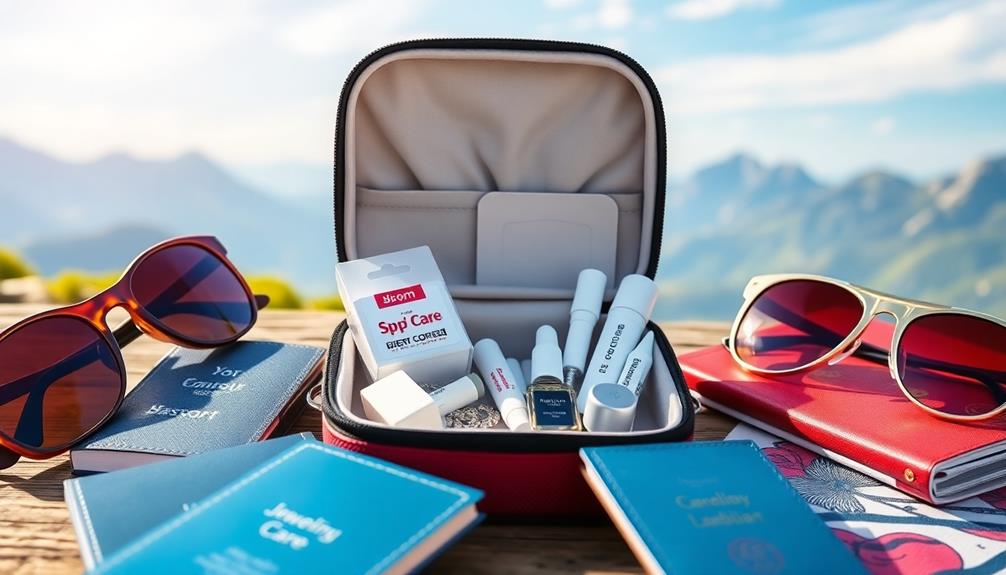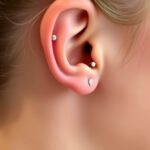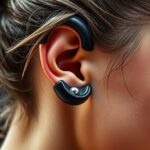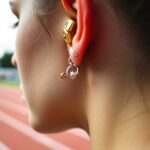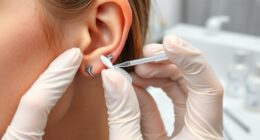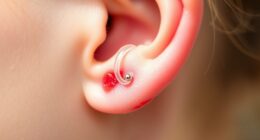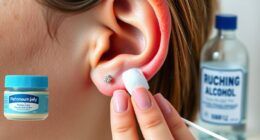As an athlete, you'll want to navigate body piercings carefully to prioritize both safety and self-expression. Certain piercings, like earlobes and nostrils, tend to be safer, while facial and nipple piercings can pose significant risks in contact sports. It's essential to choose hypoallergenic materials, like titanium, to prevent infections, and opt for low-profile jewelry to minimize snagging. Always clean your piercings post-activity to promote healing. The right choices can help you maintain your performance while staying true to your personal style. There's a lot more to uncover about integrating piercings into your athletic lifestyle effectively.
Key Takeaways
- Athletes should consider low-profile and hypoallergenic jewelry to minimize injury and infection risks during sports activities.
- Remove all jewelry, especially dangling pieces, in high-contact sports to prevent severe injuries.
- Opt for earlobe and nostril piercings, as they are less prone to snagging and injury during athletic performance.
- Regularly clean piercings post-exercise to reduce the risk of infection from sweat and dirt exposure.
- Scheduling new piercings during the offseason allows for optimal healing without compromising sports performance.
Understanding Body Piercings
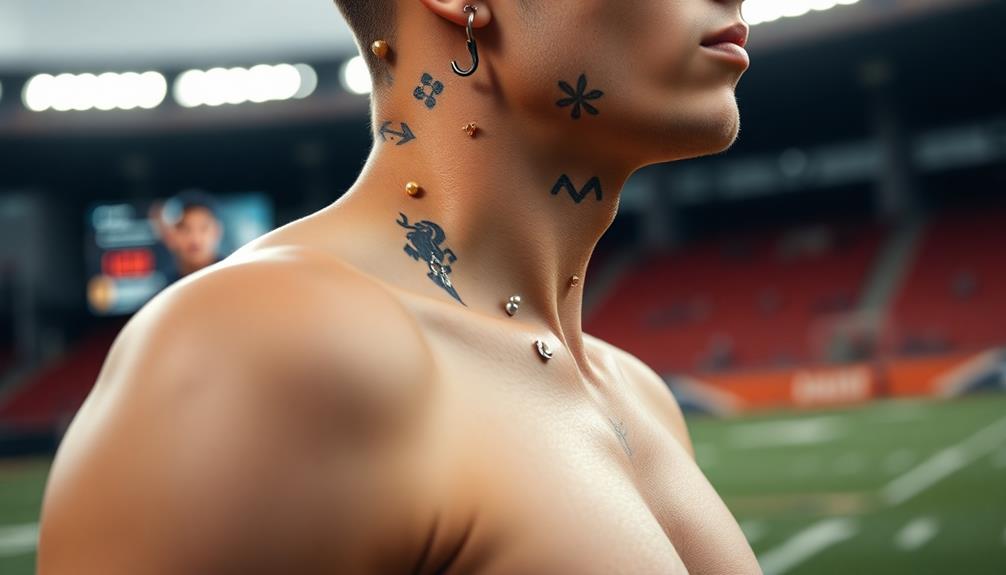
Understanding body piercings involves recognizing both the art and the risks behind the practice. Body piercing is a form of self-expression that involves puncturing the skin with a needle to insert jewelry. Common areas for body piercing include the ears, nostrils, and belly button.
If you're considering a piercing, it's important to know that earlobe piercings typically heal in about 6 weeks, while cartilage piercings can take around 12 weeks.
When you opt for body piercings, you must be aware of potential risks, such as skin infections, keloids, and allergic reactions to certain metals. To minimize these risks, choose hypoallergenic materials like titanium or surgical stainless steel for your jewelry. Proper aftercare is essential; keep an eye out for signs of infection, including abnormal redness or discharge, especially if you're active.
For athletes, understanding body piercings is particularly important. Certain types of piercings can pose risks during contact sports, leading to injuries from snagging or impact.
Risks of Body Piercings in Sports

Participating in sports with body piercings can lead to serious injury risks that every athlete should consider. Earrings, for example, are particularly vulnerable to tearing from earlobes, which can cause bleeding and scarring.
In contact sports, facial piercings can snag on opponents or equipment, resulting in painful impact injuries. Additionally, athletes should be aware of the importance of monitoring their overall health, as certain conditions can exacerbate the risks associated with body piercings, such as routine health checks.
Moreover, the risk of infection rises when piercings are exposed to sweat and dirt during athletic activities. This makes proper aftercare essential for athletes who choose to keep their body modifications. With approximately 35% of individuals with piercings reporting complications, you should be well-informed about the risks of body piercings in sports.
Rings and necklaces pose their own dangers; if caught on equipment, they can lead to severe injuries like degloving or choking hazards. This highlights the importance of jewelry removal prior to participating in any sport.
Choosing Safe Piercings for Athletes

When you're considering piercings as an athlete, think about locations that minimize injury risk, like your earlobes or nostrils.
You'll also want to choose hypoallergenic materials, such as titanium or surgical stainless steel, to keep infections and allergic reactions at bay.
Smaller, low-profile jewelry can further protect you from snagging during your activities.
Ideal Piercing Locations
What makes a piercing ideal for athletes? The answer lies in safety, healing time, and the risk of snagging during activities. Earlobe piercings are generally regarded as the best option for athletes. They're low-risk and heal quickly, allowing you to focus on your sport without worrying about injury.
Nostril piercings can also be a good choice, provided you keep an eye on any irritation, especially in contact sports.
While helix and tragus piercings offer a stylish flair, be cautious if you're engaged in contact sports. Their longer healing times and potential for snagging can lead to complications.
Nipple piercings, on the other hand, are best avoided in high-contact sports due to their susceptibility to injury.
Jewelry Material Safety
Choosing the right jewelry material is just as important as selecting the ideal piercing location for athletes. Guaranteeing jewelry material safety can greatly reduce the risks of allergic reactions and injuries during sports. Here's a quick guide to help you choose the best materials for your piercings:
| Material | Benefits | Considerations |
|---|---|---|
| Titanium | Hypoallergenic, durable | Confirm it's implant-grade |
| Surgical Stainless Steel | Low risk of allergies, strong | Look for 316L or 316LVM grade |
| Bioplast | Lightweight, flexible | Not suitable for all piercings |
| Gold (14k or higher) | Hypoallergenic for most | Avoid lower karat gold |
Opt for jewelry with a flat profile, like flatback earrings, to minimize snagging during activities. Small, snug-fitting pieces are ideal to prevent them from getting caught on equipment or clothing. Moisture-resistant materials are essential to avoid bacterial growth from sweat. Always avoid porous or soft materials, as these can harbor bacteria and break under stress, leading to injuries. Prioritize jewelry material safety to keep your piercings healthy while you stay active.
Proper Aftercare for Piercings
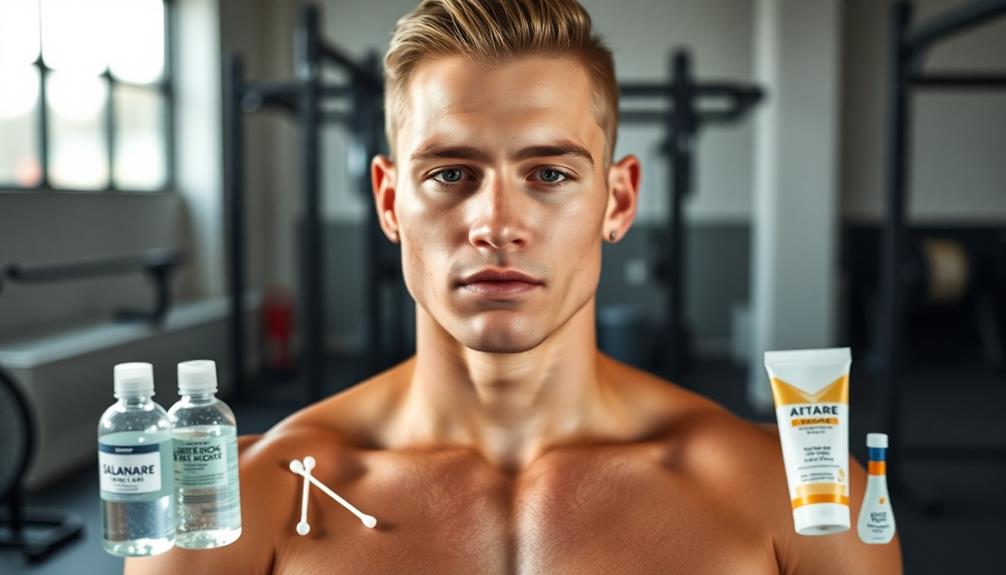
After a workout, it's essential to clean your piercings twice a day with a saline solution or mild antibacterial soap to prevent infections.
Keep an eye on the piercing for any signs of infection, like redness or swelling, and don't hesitate to seek medical help if something seems off.
Cleaning Techniques Post-Exercise
Post-exercise, maintaining the cleanliness of your body piercings is vital for preventing infections and guaranteeing proper healing. As an athlete, engaging in sports can expose your piercings to sweat and dirt, so adopting effective cleaning techniques is a must.
Consider using cute acne patches to cover any blemishes that may arise due to sweat and irritation during physical activity.
- Use a saline solution or mild antibacterial soap for cleaning.
- Gently rinse your piercing with water to remove sweat and dirt.
- Make sure no soap residue remains, as it can irritate the skin.
- Thoroughly dry the area with a clean, lint-free cloth to avoid moisture accumulation.
- Avoid using alcohol or hydrogen peroxide, which can delay the healing process.
Regularly monitor your piercing for signs of irritation or infection, such as redness, swelling, or abnormal discharge. If any symptoms arise, a professional consultation is necessary.
Remember, body jewelry made from stainless steel or hypoallergenic metals minimizes the risk of irritation, especially in contact sports where your piercings could get caught on clothing or sporting equipment.
Monitoring for Infection Signs
When it comes to body piercings, closely monitoring for signs of infection is essential for athletes. You should watch for increased redness, swelling, pain, or any abnormal discharge around your piercing, as these can indicate infection.
Regularly cleaning the piercing site with saline solution or antibacterial soap can help prevent infections and promote healing. Additionally, maintaining good overall health, including proper dental care, is important since poor oral health may contribute to a weakened immune system, making infection more likely the connection between oral health and infections.
Be vigilant about changes in temperature; if you feel warmth around the piercing, it could signal inflammation or infection. Keeping the area dry is critical, especially following sports activities, to reduce the risk of bacterial growth. Excessive moisture can create an environment where infections thrive, so avoid soaking the piercing in water.
If you notice any signs of infection persisting for more than a few days or worsening, seek immediate medical consultation. Timely intervention can prevent complications and guarantee your body piercing heals properly.
Impact on Athletic Performance

How do body piercings affect your athletic performance? The impact of body modification through piercings can vary greatly based on your sport, but discomfort and distraction are common issues.
Especially in high-contact sports, piercings can snag, leading to injury or focus loss during critical moments.
Here are some considerations you might face:
- Discomfort: Piercings may irritate you during intense movement.
- Healing Time: Longer healing times for certain piercings can increase injury risk.
- Anxiety: Self-consciousness about your piercings can distract you from your performance.
- Safety Risks: Facial piercings present dangers in close combat sports for both you and your opponents.
- Management Needs: Using low-profile jewelry or protective covers is vital to minimize risks.
Ultimately, while body piercings can be a form of self-expression, they can also hinder your performance if not managed properly.
Consider how your body modifications might affect your game and take steps to guarantee they don't interfere with your athletic goals.
Always prioritize safety and comfort to maintain your edge in competition.
Jewelry Materials for Safety
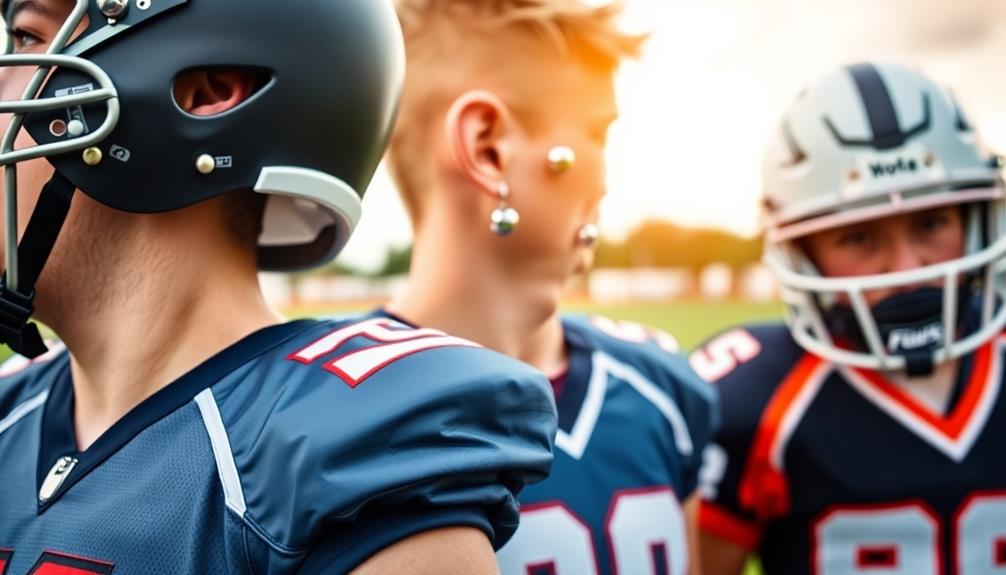
Managing body piercings effectively involves choosing the right jewelry materials to guarantee safety during athletic activities.
It's essential to opt for hypoallergenic materials like titanium and surgical stainless steel. These minimize the risk of allergic reactions and infections while you're sweating it out on the field or court.
Additionally, you should select durable, sweat-resistant jewelry that can withstand the rigors of your sport. This helps reduce the likelihood of damage or irritation to your body.
Flat-back earrings and snug-fitting designs are excellent choices since they minimize snagging risks during physical activities.
Avoid jewelry made from porous or soft materials, as these can harbor bacteria and are more likely to break during contact sports.
Regularly assess your jewelry for wear and tear; ensuring it remains comfortable and safe is imperative for your performance and well-being.
Jewelry to Avoid During Sports
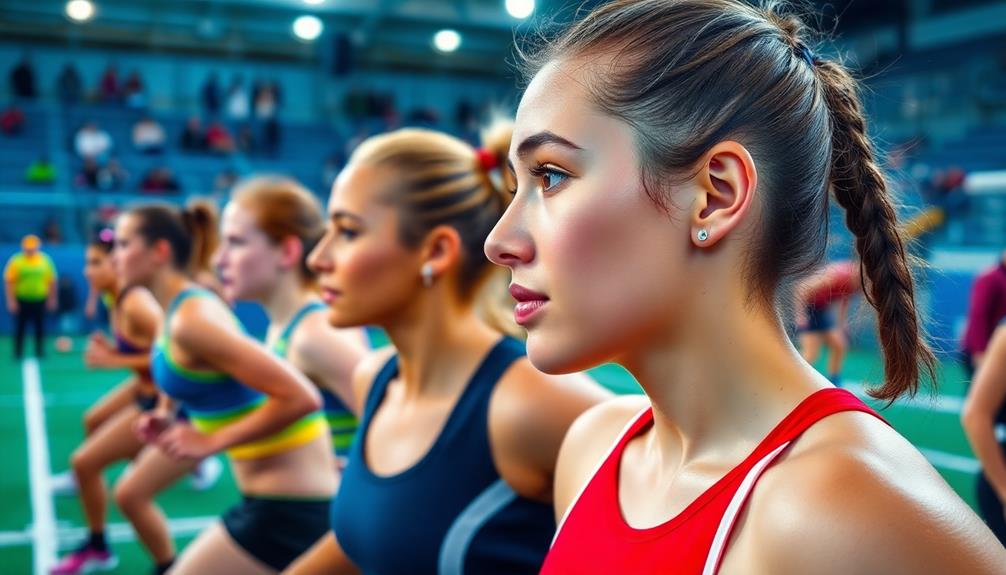
When you're gearing up for sports, it's essential to think about the jewelry you wear.
Dangling earrings, oversized rings, and heavy bracelets can lead to serious injuries or hinder your performance.
Additionally, jewelry made from porous materials can increase your risk of infection, so it's best to choose wisely.
Risky Jewelry Types
Avoiding risky jewelry types is essential for athletes who want to stay safe during sports. Wearing the wrong pieces can lead to injuries or infections, so it's vital to choose wisely.
Additionally, just as learning a new language like American Sign Language requires an understanding of nuances, athletes need to be aware of how different jewelry types can impact their performance and safety.
Here are some tips for athletes on jewelry to avoid:
- Dangling Jewelry: Large or dangling earrings can easily get caught on clothing or equipment, increasing your risk of injury.
- Soft Materials: Jewelry made from soft materials like plastic or rubber can break under impact, leading to cuts or infections.
- Porous Materials: Items that harbor bacteria can cause infections, especially during sweaty activities. Avoid porous materials.
- Heavy Jewelry: Excessively heavy pieces can be uncomfortable and increase the likelihood of injury if they get caught or pulled during action.
- Excessive Bling: Overly ornate jewelry isn't practical for active sports environments as it may snag and pose risks to you and others.
Injury Prone Designs
Injury-prone jewelry designs can greatly hinder your performance and safety during sports. As an athlete, it's essential to recognize which types of jewelry can lead to potential injuries, especially if you've just gotten a new piercing. Here's a quick guide to help you avoid hazardous jewelry during your activities:
| Jewelry Type | Risks Involved |
|---|---|
| Large/Dangling | Can get caught on equipment or clothing, leading to serious injuries. |
| Heavy Jewelry | Causes discomfort and distractions, impacting performance. |
| Soft Materials | Break easily under impact, increasing the risk of cuts or tears. |
| Porous Materials | Can harbor bacteria, leading to infections in active environments. |
| Ornate Designs | May catch on gear or create visibility issues in contact sports. |
Material Safety Concerns**
Many athletes overlook the importance of material safety when it comes to jewelry, yet choosing the right materials can greatly impact your performance and health.
Wearing inappropriate jewelry can lead to injuries, infections, or discomfort, particularly around the piercing. Here are some materials and designs you should avoid:
- Soft metals: They can bend or break easily during contact sports, increasing the risk of injury.
- Dangling jewelry: Long earrings or necklaces can get caught on clothing or equipment, leading to accidents.
- Porous materials: These can trap bacteria, raising the chance of infections, especially when you're sweating.
- Heavy pieces: They can be uncomfortable and may pose a risk if they get pulled during physical activity.
- Ornate designs: Excessively blingy jewelry isn't practical for sports environments and can create safety hazards.
Practical Tips for Athletes

To protect your body piercings while staying active, consider wearing retainers or protective covers during sports.
These options can safeguard your piercings from impact and injury, allowing you to focus on your performance. If you participate in high-contact sports, it's advisable to remove your jewelry altogether to minimize the risk of tearing or damaging your piercings.
After physical activity, verify you clean your piercings properly. Sweat and dirt can lead to infections, so take a few moments to wash the areas thoroughly.
Scheduling new piercings during the offseason is another smart move. This timing gives your body ample opportunity to heal before you dive back into sports activities.
If you still want to maintain your aesthetic appeal during competitions, consider using temporary placeholders. They can provide a stylish look while verifying your safety.
Psychological Benefits of Body Modifications

For athletes, body modifications like tattoos and piercings can be powerful tools for self-expression. These forms of body art allow you to showcase your individuality and personal identity within your sport.
Research shows that athletes with multiple tattoos often report heightened self-esteem and confidence, which can directly influence your performance during competitions.
Body art can also provide emotional support, symbolizing personal triumphs and helping you cope with the pressures of competition. This can enhance your mental resilience when facing challenges.
Additionally, participating in body modification communities can foster a sense of belonging, contributing to your overall mental well-being and social support networks.
Here are some psychological benefits you might experience from body modifications:
- Enhanced self-esteem: Boost your confidence before competitions.
- Emotional symbolism: Use art to represent personal achievements.
- Coping mechanism: Find strength in the ritual of getting body art.
- Community connection: Build relationships with others who share your passion.
- Anxiety reduction: Enjoy the therapeutic process of self-expression.
Embracing body modifications can empower you both on and off the field.
Current Trends in Athletic Body Art
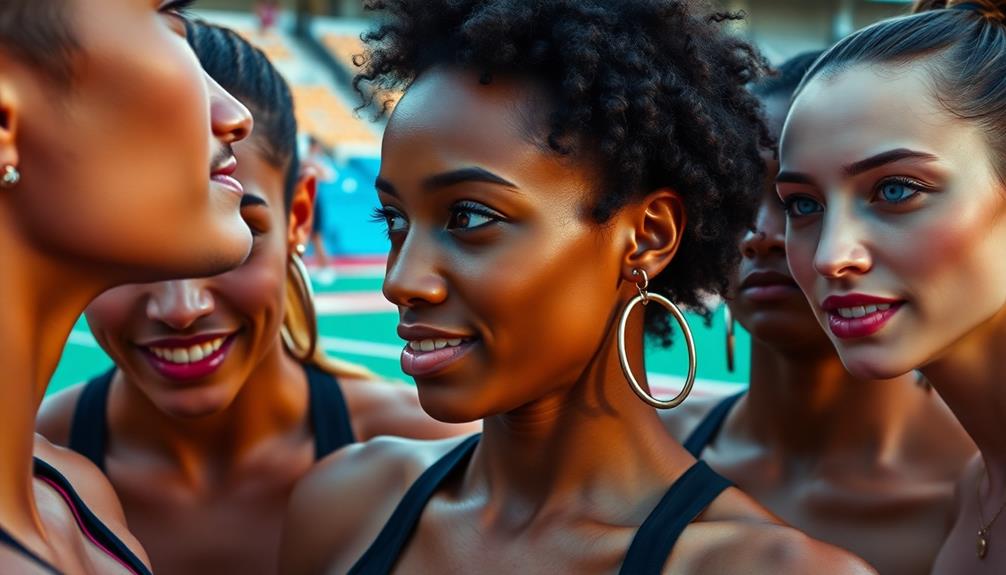
Body modifications have become a defining feature of athletic identity, with current trends highlighting the popularity of piercings and tattoos among athletes. You might notice that many athletes are choosing ear and nostril piercings since they allow for self-expression while posing low risks during most sports activities. Cartilage piercings like helix and tragus are also trendy, but keep in mind they have longer healing times and can be challenging in contact sports.
Nipple piercings are common too, but they come with higher risks in sports involving chest contact, so protective measures are essential. Tattoos are similarly on the rise, often serving as symbols of personal motivation and team spirit. Geometric and watercolor designs are especially popular these days.
Many athletes prefer getting new piercings during the offseason, ensuring they heal properly before the competitive season kicks in.
| Piercing Type | Considerations |
|---|---|
| Ear/Nostril | Low risk, high popularity |
| Cartilage | Longer healing, contact risk |
| Nipple | Higher risk, protective gear needed |
| Tattoos | Symbolic, trendy designs |
Frequently Asked Questions
Can You Wear Piercings in Sports?
You can't wear piercings in sports safely. They increase your injury risk, especially in contact situations. It's best to remove them beforehand to avoid potential damage or infection during your activity. Prioritize your safety!
Can Athletes Get Piercings?
Yes, you can get piercings, but consider the risks. Weigh the thrill of self-expression against potential injuries. Think about healing times, materials, and your sport's demands. Ultimately, make an informed choice for your safety.
How Do You Play Sports With Piercings?
To play sports with piercings, you should consider removing them for safety. If you keep them, opt for low-profile jewelry and make certain they're clean to avoid infections. Always protect them during practice or games.
How to Cover Piercings for Sports?
To cover piercings for sports, securely seal them with silicone covers or hypoallergenic tape. Stay safe by selecting breathable materials, swapping out protective gear after workouts, and ensuring comfort to avoid irritation or injury.
Conclusion
In the world of sports, body piercings can be a double-edged sword. While they let you express your individuality, the risks can be monumental if you don't take proper precautions. By choosing safe options, practicing diligent aftercare, and avoiding certain jewelry, you can enjoy both your passion for athletics and your love for body art. Remember, your body is your canvas, but it's also your instrument—treat it with the care it deserves to achieve greatness on and off the field.


